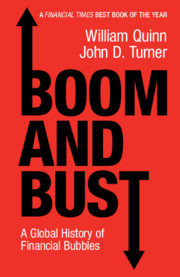Book contents
- Boom and Bust
- Boom and Bust
- Copyright page
- Contents
- Figures
- Tables
- Chapter 1 The Bubble Triangle
- Chapter 2 1720 and the Invention of the Bubble
- Chapter 3 Marketability Revived: The First Emerging Market Bubble
- Chapter 4 Democratising Speculation: The Great Railway Mania
- Chapter 5 Other People’s Money: The Australian Land Boom
- Chapter 6 Wheeler-Dealers: The British Bicycle Mania
- Chapter 7 The Roaring Twenties and the Wall Street Crash
- Chapter 8 Blowing Bubbles for Political Purposes: Japan in the 1980s
- Chapter 9 The Dot-Com Bubble
- Chapter 10 ‘No More Boom and Bust’: The Subprime Bubble
- Chapter 11 Casino Capitalism with Chinese Characteristics
- Chapter 12 Predicting Bubbles
- Acknowledgements
- Notes
- Bibliography
- Index
Chapter 5 - Other People’s Money: The Australian Land Boom
Published online by Cambridge University Press: 06 August 2020
- Boom and Bust
- Boom and Bust
- Copyright page
- Contents
- Figures
- Tables
- Chapter 1 The Bubble Triangle
- Chapter 2 1720 and the Invention of the Bubble
- Chapter 3 Marketability Revived: The First Emerging Market Bubble
- Chapter 4 Democratising Speculation: The Great Railway Mania
- Chapter 5 Other People’s Money: The Australian Land Boom
- Chapter 6 Wheeler-Dealers: The British Bicycle Mania
- Chapter 7 The Roaring Twenties and the Wall Street Crash
- Chapter 8 Blowing Bubbles for Political Purposes: Japan in the 1980s
- Chapter 9 The Dot-Com Bubble
- Chapter 10 ‘No More Boom and Bust’: The Subprime Bubble
- Chapter 11 Casino Capitalism with Chinese Characteristics
- Chapter 12 Predicting Bubbles
- Acknowledgements
- Notes
- Bibliography
- Index
Summary
Chapter 5 examines the bubble that occurred in Australia in the late 1880s. During 1887 and 1888, there was a major bubble in the price of suburban land, particularly in Melbourne. In addition, companies involved in the financing and development of urban land were created at this time and during the first half of 1888, their share prices doubled. After the peak in October 1888, the share prices of these companies and urban land prices fell sharply. We then explain why it took several years for the liquidation of the land boom to affect the wider economy. The chapter then moves on to discuss how the bubble triangle explains this episode. In particular, this was the first major bubble where investors were speculating with other people’s money, provided ultimately by the country’s banks. The spark which ignited the land boom was the liberalisation in 1887 of the restriction on banks’ lending on the security of real estate. This was the final act in a 25-year liberalisation process. The chapter concludes by examining the dire consequences of the bubble. In 1893, the Australian banking system collapsed and, as a result, Australia experienced a very long and deep economic recession
Keywords
- Type
- Chapter
- Information
- Boom and BustA Global History of Financial Bubbles, pp. 77 - 97Publisher: Cambridge University PressPrint publication year: 2020

